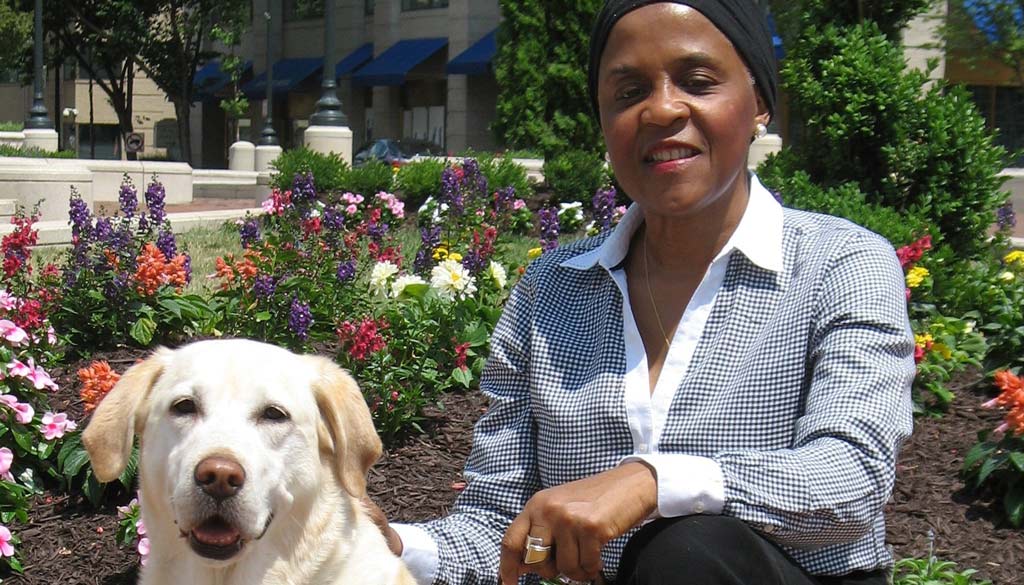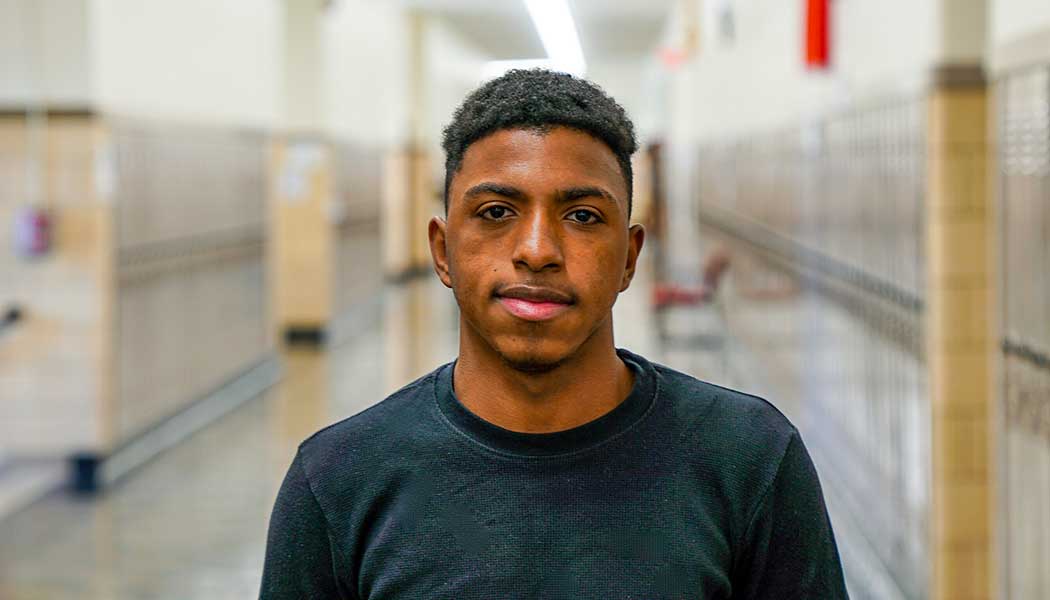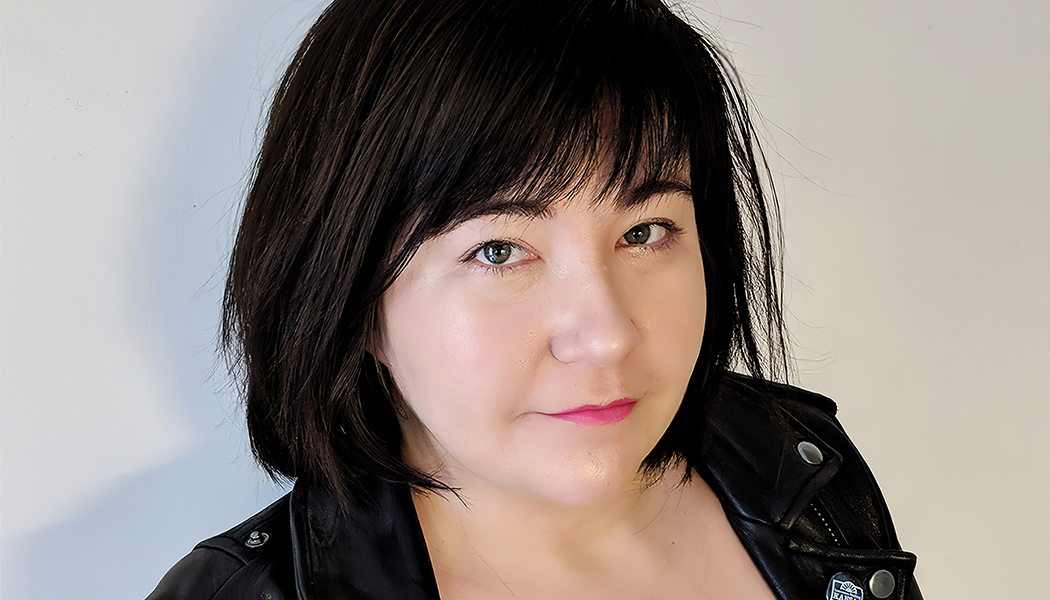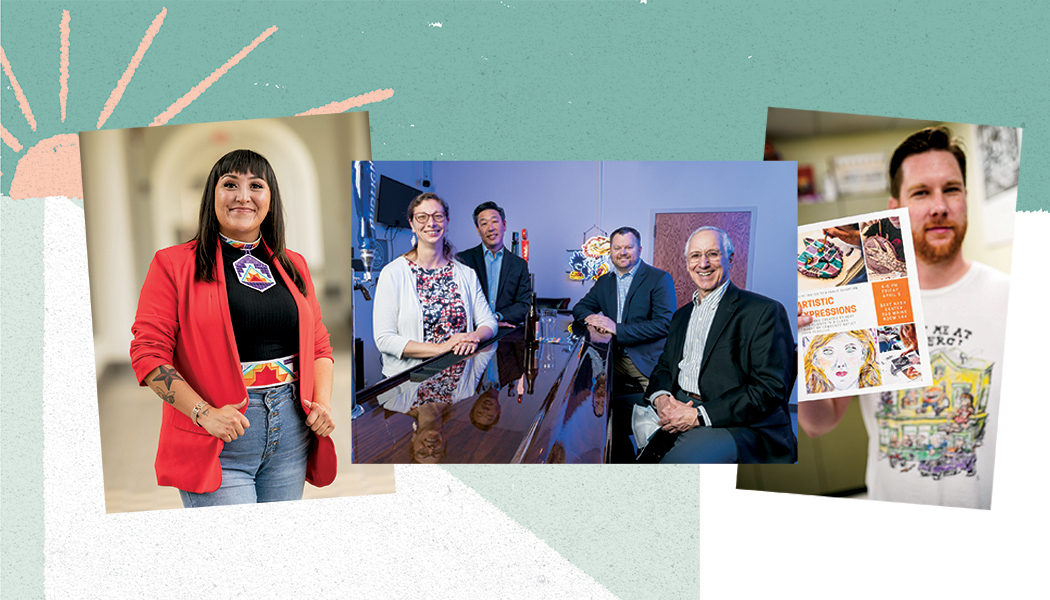Resilience in every rep: KU research explores exercise benefits for people with disabilities
Issue 4, 2024
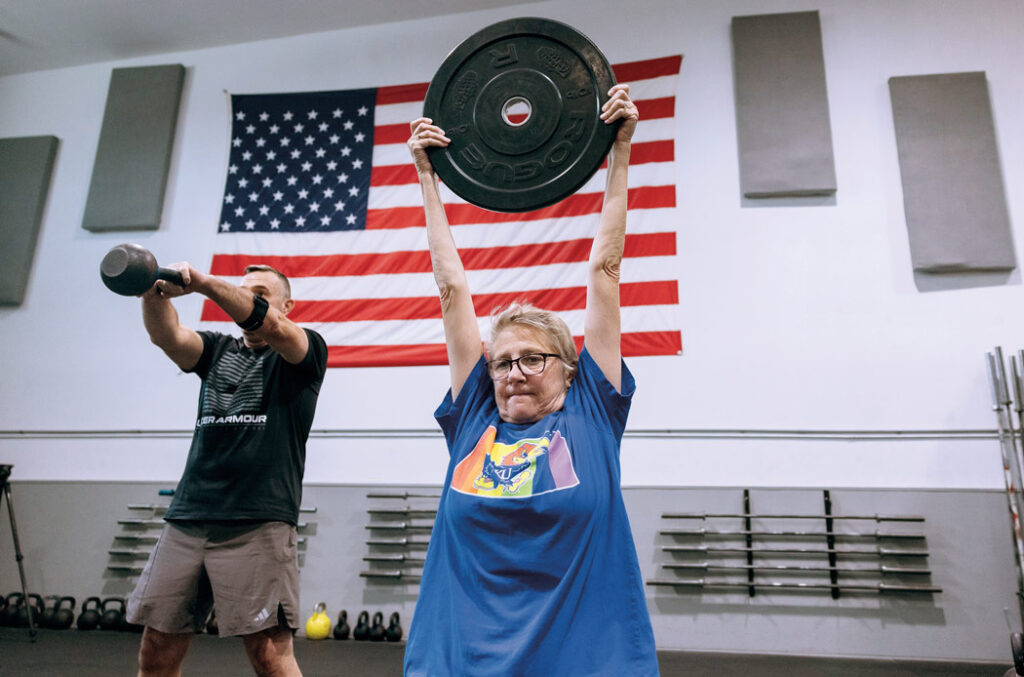
The men and women gathered for an Adaptive Athletes in Motion training session at FitNKC catch their breath while the remaining seconds between warmup and workout count down.
Lucy, a large black dog with just a bit of a gray beard, watches from her bed beneath an American flag in a corner, just beyond the black rubber flooring and exposed air ducts of the Kansas City gym.
Across the room, glowing red numbers on the digital clock tick off. “Three, two, one. Let’s go!” trainer Samantha Walker calls out as the timer hits zero.
Some participants take their seats at the rowing machines, while those in wheelchairs roll into position to use the wall-mounted vertical ski machines. Twenty minutes go back on the clock as “Welcome to the Jungle” by Guns N’ Roses booms over the speakers.
Nearest to Lucy, Mike Aldridge alternates between swiftly slicing the air with his arms during reps on the vertical machine and pulling himself up to a standing position by gripping the handles of two bars at about the height of his shoulders.
Aldridge, c’94, has trained with the Adaptive Athletes in Motion (AAIM) for over a year. He was injured in a fall four years ago that left him with permanent damage to his spinal cord.
He and the rest of the class are part of KU research to inform how high-intensity functional training (HIFT), often known by the brand name CrossFit, can benefit people with disabilities.
“I had a preconception about CrossFit when I was an able-bodied guy, and it wasn’t my thing, never was going to be—nor was exercise—was my perception,” Aldridge explains after class. “This accident changed my life, in that respect, in a good way.”
The research is led by Lyndsie Koon, assistant research professor at the KU Life Span Institute. She is studying the effectiveness of HIFT focused on people with disabilities as part of three pilot projects in several facilities in the Greater Kansas City area.
Koon, who has a doctorate in sport and exercise science with a focus on the social psychology of sport and physical activity, was skeptical of HIFT at first. Then a friend convinced her to go to a CrossFit class.
“I thought I knew just about everything about exercises,” she says. “I finally went, and it was like, ‘Oh, I’ve been doing it wrong this whole time.’”
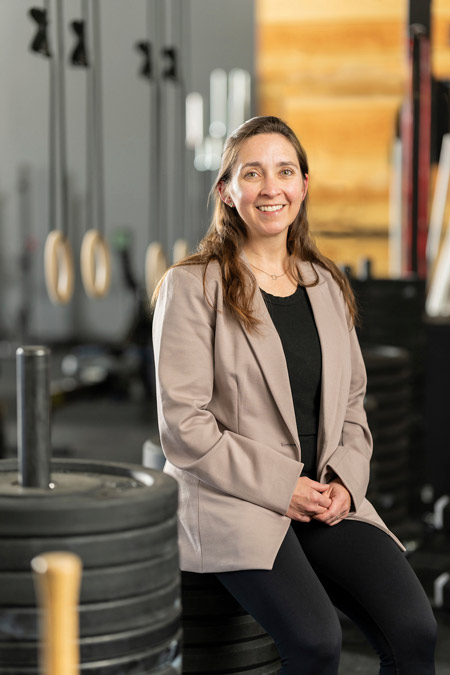
As a former athlete, Koon had been studying the health and activity of older adults. She thought HIFT, with its focus on individually tailored workouts, might help fill an important need for physical activity for people with disabilities.
Koon says she has seen HIFT work for a variety of people—from ages 8 to 80, people with amputations or spinal cord injuries, and individuals with Down syndrome or cerebral palsy.
“The methods of CrossFit are unbelievably effective. And because they’re so adaptable, anybody can do it,” she says.
The Need to Adapt
The roots of Koon’s research program began when she met Josh Snyder, owner and manager of FitNKC. Koon had spoken with Alec Barowka, ’16, at Kaw Valley CrossFit in Lawrence, and he recommended Snyder as someone to connect with.
Snyder, who developed the AAIM program, emphasizes that fitness and its benefits are for everybody. Several years earlier, before he started his first adaptive class, his nonprofit Chalk Up For Burpees program introduced HIFT to veterans and first responders as a method to build health, healing and community.
However, Snyder didn’t have an adaptive fitness class when, in 2017, a former first responder with a traumatic brain injury came into his gym in a wheelchair to ask if Snyder could train him too.
Snyder wasn’t sure he could.
“So, I’m just going to say no, right?” Snyder recalls. “Well, that doesn’t sit very well with me. So, I said, ‘The answer is no for right now, but I’m going to figure this thing out.’”
To begin helping individuals with disabilities, Snyder completed certification for adaptive and inclusive training through the Adaptive Training Academy, an organization established in 2012 by adaptive fitness community leaders. Training people who have limited mobility, are recovering from a stroke, have chronic health conditions or have spinal cord injuries takes some thought, Snyder says, but it isn’t as difficult as he feared it would be.
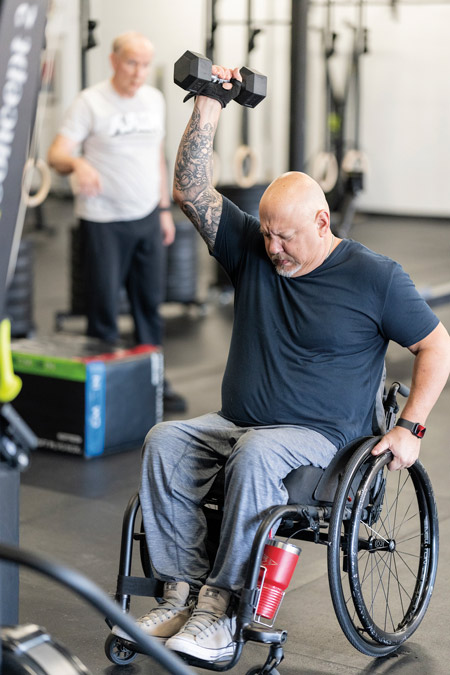
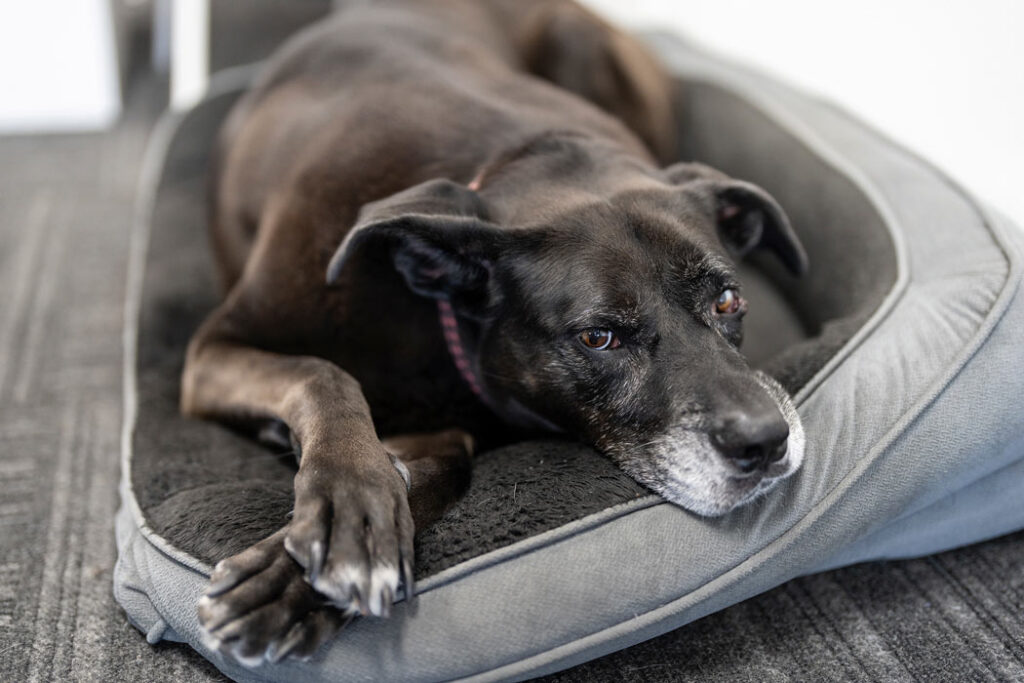
“It’s just looking at something and knowing, ‘Hey, what is it we are trying to do to our bodies?’ And then from that standpoint, ‘How do you get creative with that?’”
Before beginning, all AAIM participants complete two orientation sessions with HIFT trainers who inventory their health and physical condition and work with them to adapt routines before they join others in completing the workout of the day, or WOD.
“Josh has a knack for this stuff,” Koon says. “He can take any disability type and go, ‘OK, I see where you are. Now, I’m going to get you to here based on your capabilities and goals.’”
Adaptations, which are modifications in how an exercise is performed, may seem small, but they are necessary. Someone who cannot do pushups, for example, can work the same muscle group by tossing a medicine ball against a wall. An adaptation could also involve lowering the handlebars of a ski machine so they can be reached from a seated position, or rotating the screen of a rowing machine so it can be used by a person seated in a wheelchair on the other side.
Mike Aldridge knows firsthand how small things can make a big difference. On July 11, 2020, just one day after his 50th birthday, Aldridge was working on his roof when his hammer slipped from his hand. He asked his wife, who was holding the ladder, to retrieve it for him.
“She didn’t want to let go,” Aldridge remembers. “But it was hot up there, and I’ve rolled the dice so many times in my life. I never thought I was going to fall.”
Aldridge insisted—“I probably used some expletives,” he says—and his wife reluctantly took her first few steps away before “the ladder slipped completely out.” The impact of the fall broke bones throughout his body and fractured his spine, leaving him paralyzed from the waist down.
After his injury, Aldridge recalls lying in the hospital, feeling broken everywhere.
“The thing I was saying to myself,” he says, “is that I got to get strong.”
His first physical therapy class focused on just getting out of bed. It was a struggle, for the first time using only his upper body to maneuver himself.
After training with AAIM, Aldridge now has the strength to get out of bed and much more.
“You get into this zone, and you start feeling the results, seeing the results, and then sharing the results with other people,” he says. “If I could do anything, I would want to see this place full all the time.”
Function of Fitness
HIFT challenges participants to focus on functional movements, considered more natural with real-life application, rather than on sports- or gym-specific movements.
Functional movements are actions that mimic activities of daily life, such as walking, sit-to-stand, bending to pick something up or reaching to put something away. This term is used to distinguish HIFT from exercises that focus on isolated muscles or that are not part of everyday movements.
There’s nothing wrong with performing calf raises, for instance, but such exercises may be less helpful to someone whose goal is to improve their health and independence rather than compete in a physical activity.
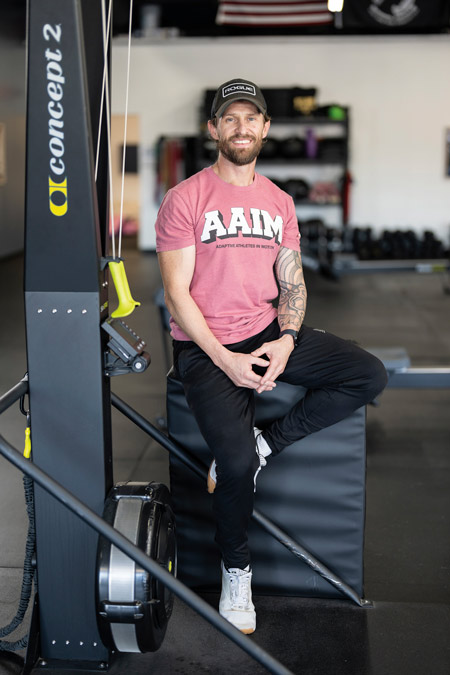
HIFT classes focus less on muscles needed to bench press a certain weight, for example. Instead, strength and movement efficiency are built around more functional activities—getting in and out of bed, retrieving an object from the floor, putting a bag in an overhead bin on an airplane, or picking up a child.
“The basis of this HIFT stuff is these functional movements,” Koon says. “These are things people with disabilities have to do as well. They just do it a little bit differently.”
Maureen “Moe” Flynn-Hart, a retired high school coach who began training girls sports teams right after Title IX was enacted, is used to working out. But a stroke left her with tremors that made it difficult to function as she used to.
“Exercise is control, I feel, for motivation and wellness,” she explained with the assistance of a writing app on her phone during the second orientation session for the adaptive HIFT classes back in January. She practiced standing from a seated position without using her arms.
At FitNKC several months later, Flynn-Hart, ’98, reflects on her progress. Having a routine of physical fitness, she says, helps her cognitive abilities. On this day, she does shoulder touches from a straight plank position after taking a break from the rowing machine.
In her 70s, Flynn-Hart is raising her active 3-year-old granddaughter, who loves riding her bike and trying to reenact the Olympic gymnastics she sees on TV. The energetic young girl keeps her busy.
“I can’t run,” Flynn-Hart says. Still, “I have to create leverage for me to keep up.”
While people with disabilities worldwide engage in HIFT, Koon says there is little to no empirical evidence on the effectiveness of this type of exercise for the disability community.
Much of Koon’s research is focused on documenting how adaptive fitness can help empower and improve people’s independence. While her data have shown increases in grip strength and improvements in balance and flexibility, those aren’t the factors that motivate her work.
“I want to know that these people are getting on the floor to play with their grandchildren or carrying in their groceries alone,” Koon says. “The functional independence piece of it is, I think, the most compelling.”
Confidence and Community
For the first time in her life, AAIM participant and author Rebekah Taussig loves going to the gym, meeting up with the other people in class and challenging herself physically. It is an experience the KU alumna didn’t always think she could have.
“I’m 38. And this is the first time I’ve ever worked out consistently with other people,” she says.
Paralyzed at age 4, she says she didn’t fit into “that traditional, tiny, narrow box” around which most exercise plans are designed. That changed when she joined AAIM.
“When I first started working out at this gym, I would have this big smile on my face just, like, lifting weights,” says Taussig, PhD’17. “I’ve never done that. And it was amazing.”
She attended accessible exercise classes as part of a study several years ago, but when the study ended, so did her workouts. This time, she has stuck with it, and she feels pride in the strength she’s able to demonstrate to her family, including her 4-year-old son.
“One thing that I actually really love about it is the way that my son perceives it,” she says. “It matters to me that he sees me pushing myself physically.”
While she exercised some in the past, what has felt different to her this time is the support from her trainer. But what she loves most has been working out with people like herself.
“This is the first time I’ve ever worked out consistently with other people,” she says. “That feels really important to me.”
Taussig wrote the bestselling memoir Sitting Pretty (“In Her Words,” issue No. 1, 2021), which discusses growing up with physical disabilities in a body unlike those around her. Because she works from home, she says, the community aspect of HIFT has been important to her. Her fellow gymgoers greet her when she shows up and ask about her if she doesn’t.
“We’re all doing similar things together, but in our own ways. And there’s something about that social component of it, like we’re all doing this together.”
Watch: Get a look inside Josh Snyder’s accessible HIFT program, Adaptive Athletes in Motion, and hear from Lyndsie Koon on her research into the benefits of high-intensity functional training.
Having a gym buddy or workout community can increase motivation to stick to fitness goals, research has shown. HIFT has a built-in culture of community that keeps participants engaged, which Koon says is important to her goal of improving people’s health.
This is one of the reasons Koon’s research projects take place in the real-world environment of a gym and not in a lab, where she would have much more control over variables.
“I get the point of that, because we do need that sort of efficacy research,” Koon says. “But what’s the point if they have to stop exercising after the intervention is done?”
About 70% of those who join the classes continue with the program even after her research is finished.
“I like doing it out in the community, because these people don’t have to stop once the research is done,” Koon says. “And that’s why I haven’t pulled it into a lab.”
The Need for Understanding
Despite the benefits of exercise for maintaining brain health, managing weight, reducing disease risk, strengthening bones and muscles, and improving the ability to complete everyday activities, most community-based facilities are not accessible, or even inclusive, to people with physical disabilities, Koon says.
It is an area understudied by researchers and overlooked by physicians.
Lack of exercise can contribute to reduced muscle mass, coordination, flexibility and bone health. Other risks include increased likelihood of chronic disease, osteoporosis, high blood pressure, excess body fat, cognitive decline, anxiety and mood disorders.
Even though Taussig knew about the importance of regular exercise, for most of her life, “I didn’t get my heart rate up. I didn’t, you know, push myself until I was sweating.”
Her doctor encouraged her to work out, but she says the conversation ended there.
“I didn’t do any sports, and I just didn’t exercise at all. It just didn’t feel like something that I could do or that I was very capable of doing.
“When I would see my doctors, they’d be like, ‘Well, you know, you should be getting your heart rate up three times a week,’” she says. “It was like, ‘OK. Where would you suggest I do that?’”
AAIM participants haven’t been referred to the program by a physician. Instead, many of them heard about it from neighbors, friends, social media posts or their community.

Research shows doctors are more likely to suggest surgery or pharmacological treatment than exercise for people with disabilities. And outside of short-term physical or occupational therapy, exercise practices are not well translated for the millions of people in the U.S. who have disabilities.
After Brian McMillan, 65, lost mobility of his legs in a motorcycle accident, he worked with a therapist to learn how to get dressed, move around and take care of himself. “But that only lasts for so long, and then, after that, you’re just kind of on your own,” McMillan says. “There’s a huge need in the community for people that are disabled.”
Less than half of adults with a mobility disability are physically active. Physical limitations are the most frequently reported obstacle to exercise for people with disabilities, with 57.5% describing this as a challenge to participation, according to “Understanding Exercise Challenges and Barriers for Older Adults with Mobility Disabilities,” an article that Koon co-authored and published in Proceedings of the Human Factors and Ergonomics Society Annual Meeting in 2020.
Even if people don’t have a disability today, there’s no guarantee they won’t tomorrow.
“Most people age into a disability,” Koon says. “We all kind of do that, whether it’s our eyesight or some sort of mobility disability.”
Physical fitness can help delay some of the expected effects of aging, which is important to retaining physical abilities. Taussig says the challenges of aging with a disability aren’t common topics of conversations with her doctors.
As she nears 40, she’s paying more attention to her body.
“That’s kind of a newer idea, to me—learning to take care of my body,” she says. “I think about that in terms of long term, wanting to be able to sustain a certain level of physical independence, and I’m wanting to make sure that I’m staying on top of that now.”
Permanent or temporary disabilities can happen to anyone at any time. In fact, after age 75, the U.S. Census Bureau reports, 46% of Americans will have a disability. This is one of the reasons Taussig says adaptive fitness can be important to people both in and outside the disability community.
“A lot of people with aging bodies feel insecure joining a yoga class or something because they don’t feel like they’ll be able to fit in or match or keep up,” Taussig says.
When she tells others about her experiences with AAIM, they often share that they’d love something like that.
“It just made me think, ‘How many people across the board would benefit from a little bit of a reimagining what it means to go to a CrossFit class or be a part of a gym?’” Taussig says. “The art of just creating more points of access—it’s good for everyone.”
As people age, fitness is even more important for function.
Muscle mass is known to decline after age 30, with an average 40% decrease by age 80. Regular exercise has positive effects mitigating the many hallmarks of aging, with several studies pointing to an increase in life expectancy by as much as four to six years.
But engaging in exercise carries higher risks for people who are older or have a disability, which is why working with experienced trainers who are familiar with an individual’s condition is important.
Adaptive athlete Martha Hodgesmith, c’74, l’78, who retired from KU as associate director and knowledge translation manager of the Life Span Institute’s Research and Training Center on Independent Living, believes this is one of the strengths of the AAIM classes. All trainers in the program must earn Adaptive and Inclusive Trainer certification from the Adaptive Training Academy.
“People with disabilities and older people want to be fit for functional purposes,” Hodgesmith says. “Of course, everybody wants to be fit, but the key is you can’t hurt yourself. And (the trainers) are very attentive in this project.”
While all research has meaning, Hodgesmith says, it has been exciting to participate in work that has been so important to her and many others.
Access to physical fitness is no small thing.
“This literally changes people’s lives every day,” she says.
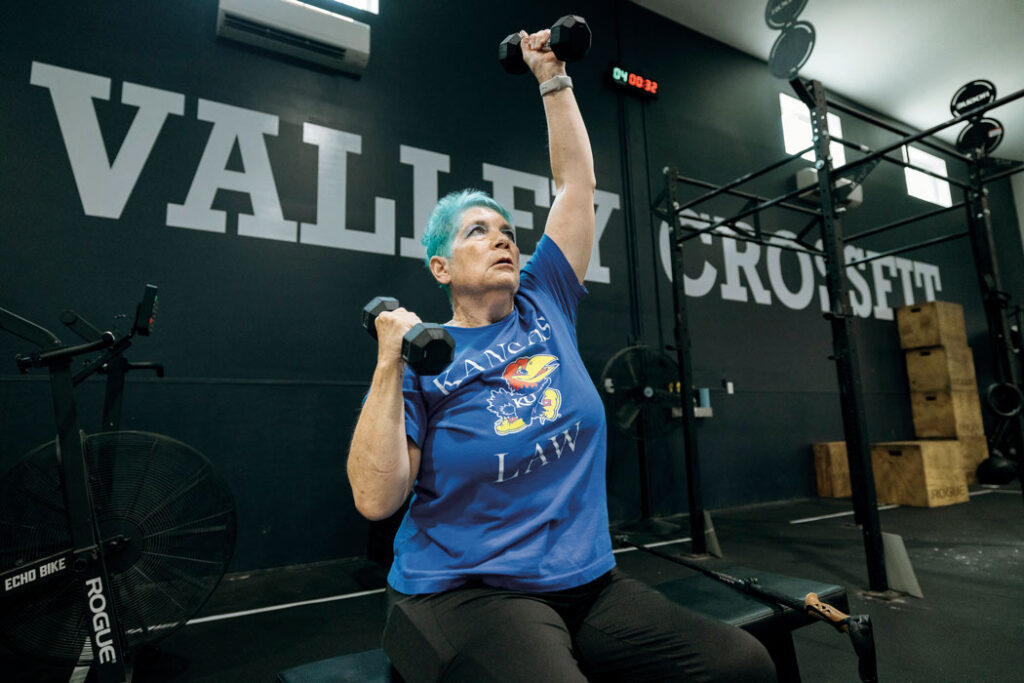
During classes, adaptive coaches like FitNKC’s Samantha Walker who are trained to understand safe movement patterns keep an eye out for anyone who may be overexerting themselves by using too much weight or intensity. This means not only gauging form and speed of movement, which can vary between individuals, but also body language and facial expressions, Walker says: “In this way, we are able to provide safe and effective instructions and corrections during workouts that are feasible and catered to each athlete.”
In many ways, she adds, the AAIM training isn’t too different from training people without disabilities. While the needs might vary, the approach is the same—assessing the individual’s capabilities and limits and having empathy for their personal situation.
“It may require a bit more setup and potentially more assistance throughout the workout sessions, but it is the same attention to detail we would provide to any athlete regardless of whether they have a disability or not,” she says.
As an example, she describes a participant who is an above-the-knee amputee and how his form differs from other exercisers during squats.
“We know his heel needs to come off the ground to allow proper form, whereas proper form for a bipedal athlete would be to keep both heels on the ground,” she explains.
Walker says trainers are intentional about making sure each person feels comfortable saying no or communicating concerns, including pain. Trainers need to know how to push participants to challenge themselves without forcing them to do anything that increases the risk of injury or emotional distress.
One potential benefit of HIFT classes for people with disabilities is that the CrossFit-style programs are widespread throughout the country and internationally. But while the reach of adaptive HIFT is virtually limitless, programs must first be willing to host people with disabilities. Although some do actively include people with disabilities, others have yet to follow. Empirical evidence generated by Koon’s research could help change that, by showing that these adaptive HIFT programs are indeed feasible and effective.
For Walker, the value of empowering people with disabilities through training is personal. Her sister lost her sight in 2018, and at the time, it seemed all hope was gone.
“This program has shown me and the athletes who work their butts off that the only limit is inside the mind,” Walker says. “My hope is that one day every single gym in America offers this program or something similar to it.”
Christina Knott, a graduate student in digital integrated marketing at KU, is a communications specialist at the Life Span Institute.
Lynne Ellis, Ray Petty and Martha Hodgesmith photos by KU Marketing
Lyndsie Koon, Mike Aldridge, Lucy the dog and Josh Snyder photos by Steve Puppe
/
